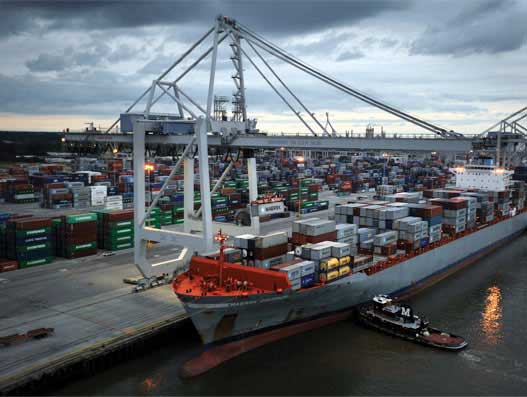
Incredible efficiencies at work in Georgia Ports
Improving consumer confidence, new customers and shifting cargo from West to East Coast of the US are all reasons for good performance by Georgia’s deepwater ports — Savannah and Brunswick. Ports in Savannah and Brunswick managed by Georgia Ports Authority (GPA) continue to set new highs as more containers, bulk goods and cars moved through […]

Improving consumer confidence, new customers and shifting cargo from West to East Coast of the US are all reasons for good performance by Georgia’s deepwater ports — Savannah and Brunswick.
Ports in Savannah and Brunswick managed by Georgia Ports Authority (GPA) continue to set new highs as more containers, bulk goods and cars moved through state ports in the 2014 fiscal. GPA moved more than 29 million tonnes of cargo, three million twenty-foot equivalent container units (TEUs) and more than 700,000 auto and machinery units in 2014. The rising tide of the economy is literally bringing more imports to the US and sending more exports to global markets. Perhaps Georgia’s success is no accident but it is a reflection of the positive sentiments in the business after a rather prolonged downturn.
The Port of Savannah handled a record 3.14 million TEUs in FY14, up by 6.3 percent or 186,567 TEUs compared to the previous year. It was the first time for the port to move more than three million TEUs in a fiscal year. The added volume contributed to a record year in total tonnage. In the 12 months ending June 30, GPA moved 29.4 million tonnes of freight, up by eight percent or 2.17 million tonnes.
In roll-on/roll-off cargo, the Port of Brunswick’s dedicated auto and machinery terminal moved 674,327 units in FY14. Savannah’s Ocean Terminal added another 26,375 for a record total of 700,702 units. GPA Ro/Ro cargo improved by 63,760 units or 10 percent on the year. Breakbulk cargo saw a gain of 5.2 percent in FY14, growing by 129,861 tonnes to reach 2.63 million tonnes. Meanwhile, bulk cargo expanded by 8.4 percent, or 212,086 tonnes, to reach 2.73 million tonnes of agricultural and other bulk goods moved across GPA docks.
“Improved confidence among US retailers, newly added port customers, and shifting cargo from US West to East Coast are all fueling the growing cargo volumes at Georgia’s deepwater ports. New customers added in FY2014 included everything from sporting good and appliance makers, to produce marketers taking advantage of South America’s growing season to provide fresh fruits and vegetables to US consumers through the winter,” said Curtis Foltz, Executive Director, GPA. Foltz credits the incredible efficiencies at the Port of Brunswick as the reason for the 10 percent increase in Ro/Ro traffic. “New imports from Honda, exports from Toyota, and business from about 20 other auto manufacturers now takes advantage of our massive facility there and its superior connections to population centers around the region,” he added.
South American citrus, grapes and blueberries will arrive sooner and last longer for consumers in the Southeastern US thanks to APA’s participation in a US Department of Agriculture pilot programme. “South American fresh fruit destined to the Southeast market has traditionally been shipped to Northern US ports. Delivery to Savannah means fruits won’t have to be trucked as far to reach Southeastern markets, allowing fresher offerings for stores and longer shelf life for consumers,” said Foltz. Starting this month, the Port of Savannah will begin handling fruit from South America that has undergone cold treatment, a process that prevents the transmission of agricultural pests.
At the Port of Savannah, the GPA operates nearly 10,000 feet of berth space on a first-come, first-served basis. No waiting on limited docking leased to a single shipping line. Our nine berths, backed by 25 ship-to-shore cranes and a 1,200-acre container operation, give us the flexibility to adjust to changes in shipping schedules. Because we dedicate dock space based on customer needs, ships can get in and get out more quickly. Cargo moves to market with greater speed, and the companies that own the freight start seeing a return on it faster.
The GPA expects to see similar growth in Fiscal Year 2015. “We are conservatively estimating five percent growth in overall tonnage and container throughput, with our targets at roughly 31 million total tonnes and 3.3 million TEUs,” said Foltz. “As more companies choose all-water routes to serve the US Southeast, we will see a steady expansion in containerized cargo. This growth will also be driven by the increasing number of distribution centers operated by retailers and by 3PLs,” he added.
GPA is also expecting to see private investments in new and expanding refrigerated storage facilities in the Savannah area which is likely to support an influx of refrigerated cargo. “While agricultural exports such as poultry make up the majority of our cool-chain cargo, we expect refrigerated imports to expand as more produce companies tap the Port of Savannah to reach important markets such as Atlanta, Charlotte and Memphis,” said Foltz.
In addition to the four Super Post-Panamax ship-to-shore cranes the Port of Savannah commissioned last year, the GPA has purchased another four ship-to-shore cranes and 20 new rubber-tired gantry cranes. GPA’s current fleet stands at 25 ship-to-shore cranes and 116 RTGs – more than any other single-operator terminal in the US. The ship-to-shore cranes are due to arrive in 2015. The infrastructure upgrade with the greatest impact, however, is the Savannah Harbor Expansion Project. The project will increase harbor depth from 42 feet to 47 feet.

